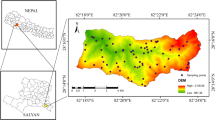Abstract
This study was undertaken to prepare an inventory on soil erosion of a hilly river watershed — the Aglar watershed, part of Tehri Garhwal and Dehradun districts (U.P.), using terrain physiography and soil survey data obtained from interpretation and analysis of Landsat TM FCC (1:62,500 scale) and limited ground investigations.
The watershed is divided into four broad physiographic units viz. higher Himalayas (> 2000m elevation); lower Himalayas (< 2000m elevation); river terraces and flood plains. Each physiographic unit has been further divided into subunits on the basis of aspects and landuse. Three major orders of soils viz. Inceptisols, Mollisols and Entisols were found in different physiographic units. Soil, and land properties of soilscape units viz. soil depth, texture, structure, slope, landuse and soil temperature regime were evaluated for soil-erosion hazard. The results indicate that in the whole watershed 19.13%, 45.68%, 26.51% and 7.92% areas have been found to be under none to slight, moderate, severe and very severe soil erosion hazard categories, respectively.
Similar content being viewed by others
References
Bali Y P (1983). Problems in watershed management in various River Valley Projects (RVPS). Proc.National Symp. on Remote Sensing in development and management of water resources, SAC, Ahmedabad, 10–14 pp.
Bergsma E (1980). Provisional rain-erosivity map of the Netherlands, In book onAssessment of Erosion (Eds. M De Boodt and D Gabriels), Pub. John Wiley & Sons, 121–126 pp.
Biswas R R (1986). Photo-geomorphology of subwatersheds Mhza and their soils in Matchkund Catchment, A.P. State,Indian J. of Landscape Systems and Ecological Studies, 9 (2): 12–16.
Campbell W J (1979). In book onSatellite Hydrology (Eds. M Deutsch, Wiesment D R and Rango A); American Water Research Association, 616–621 pp.
Karale R L (1987). Applications of Remote Sensing for watershed management. Lecture notes, Short term course entitled “Application of digital MSS and TM data for quantification of Agricultural and Forest Resources”, CSRE, IIT, Bombay.
Karale R L and Das S N (1986). Aerial photo-interpretation for detailed soil survey in part of Ajoy Catchment, Bihar, India. Proc.Int. Seminar on Photogrammetry and Remote Sensing for developing countries, Vol. 1, New Delhi.
Karale R L and Saini K M (1986). Resources inventory in parts of Rajasthan using Remote Sensing Technology. Remote Sensing Applications Seminar, JOdhpur.
Mitchell C W (1981). Soil degradation mapping from Landsat imagery in North African and the Middle East.Geological and Terrain Analysis studies by Remote Sensing (Eds. J A Allan and M Bradshaw), Remote Sensing Society, London, 49–68 pp.
Pofali R M and Singh S R (1983). Photogeomorphic analysis for evaluation and management of the Narmada Basin. Proc.National Symp. on Remote Sensing in Development and Management of Water Resources, SAC, Ahmedabad, 105–110 pp.
Saxena R K, Murthy R S and Barthwal A K (1983). The soil resources appraisal and landuse planning in Tons basin of Garhwal Himalaya. NNRMS Seminar, May 10–12, NRSA, Hyderabad, I-31.1 to I-31.29 pp.
Sharma J K and Kalia M M (1987). Use of aerial photographs in the study of watershed characteristics.J. Indian. Society of Remote Sensing, 15 (2): 1–6.
Singh B M (1983). Use of remote sensing techniques for catchment surveys — a case study of Jobat Project. NNRMS Seminar, May 10–12, NRSA, Hyderabad, I-29.1 to I-29.15 pp.
Spanner M A, Strahler A H and Estes J E (1983). Proc.16th Int. Symp. Remote Sens. Environ.
Steglik O (1982). Methods of interpreting soil erosion from remote sensing imagery.Issledovaniye/Zemil/IZ/Kosmosa, No. 2.
Stephens P R and Cihlar J (1982). Mapping erosion in New Zealand and Canada, InRemote Sensing for Resource Management (Eds. C J Johannsen and J L Sanders), 232–242 pp.
USDA (1975). Soil Taxonomy — a comprehensive system for making and interpreting soil surveys.Agricultural Handbook No. 436, Government Printing Office, Washington, D. C., U.S.A.
Author information
Authors and Affiliations
About this article
Cite this article
Saha, S., Singh, B. Soil erosion assessment and mapping of the algar river watershed (uttar pradesh) using remote sensing technique. J Indian Soc Remote Sens 19, 67–76 (1991). https://doi.org/10.1007/BF03008122
Received:
Revised:
Issue Date:
DOI: https://doi.org/10.1007/BF03008122




